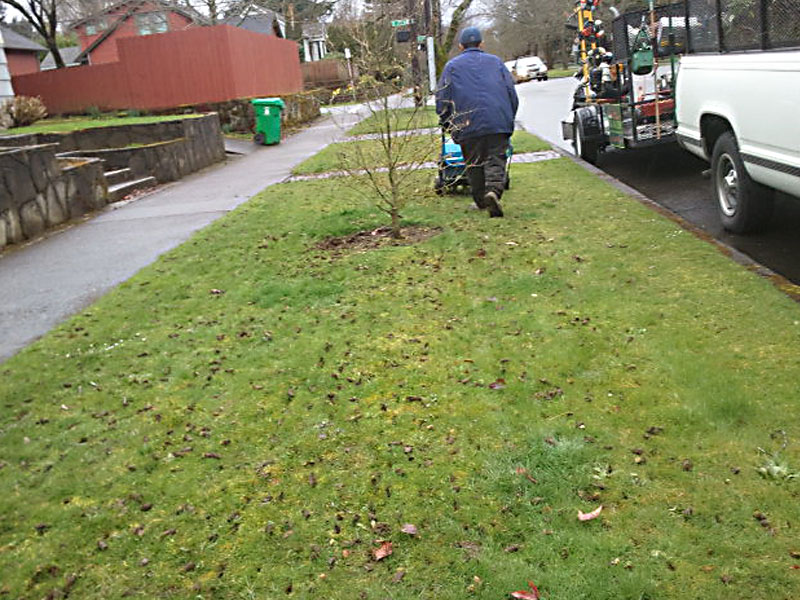Lawn Aeartion?
Lawn Aeration
What will aeration do for my lawn?
As lawns age or sustain heavy use from play, sports activities, pets, vehicle traffic and parking, soil compaction can result. Soil compacting forces are most severe in poorly drained or wet sites. Compaction greatly reduces the pore space within the soil that would normally hold air. Roots require oxygen to grow and absorb nutrients and water. Compaction reduces total pore space and the amount of air within the soil. It has a negative impact on nutrient uptake and water infiltration, in addition to being a physical barrier to root growth. This results in poor top growth and lawn deterioration. Core aeration can benefit your lawn by:
- Increasing the activity of soil microorganisms that decompose thatch.
- Increasing water, nutrient and oxygen movement into the soil.
- Improving rooting.
- Enhancing infiltration of rainfall or irrigation.
- Helping prevent fertilizer and pesticide run-off from overly compacted areas.
What is lawn aeration?
Lawn aeration involves the removal of small soil plugs or cores out of the lawn. Although hand aerators are available, most aeration is done mechanically with a machine having hollow tines or spoons mounted on a disk or drum. Known as a core aerator, it extracts 1/2 to 3/4 inch diameter cores of soil and deposits them on your lawn. Aeration holes are typically 1-6 inches deep and 2-6 inches apart. Other types of aerators push solid spikes or tines into the soil without removing a plug (spiking). These are not as effective because they can contribute to compaction.
Core aeration is a recommended lawn care practice on compacted, heavily used turf and to control thatch buildup.
Early March is a great time to think about scheduling your lawn aerating service for spring. Over the previous summer, the lawn will have been subjected to a lot of traffic, causing compaction. Soil compaction leads to a variety of other problems, if not alleviated, so it is best to alleviate compaction as early as possible in the year. Aerating will also take care of any thatch buildup problem your lawn might be suffering from. A little bit of thatch is fine. Too much thatch can lead to many of the same problems that soil compaction causes.
Why Spring for Aerating the Lawn?
Lawn aerating is helpful for the health of the grass, but it is also stressful because it disrupts the roots and the regular growing habit of the grass plant. Aerating in the spring, when the lawn is actively growing, gives the lawn a chance to recover more quickly than aerating during the summer or late fall when the lawn is not growing as quickly. If you didn't get a chance to aerate the lawn in the fall, the spring is, obviously, the next best choice! The spaces opened up by aeration will allow you to keep your lawn healthy all summer long. Air, water and fertilizer will penetrate the soil more easily after aeration, ensuring an overall healthier lawn.
Prevent these Problems with Spring Aeration
Aerating can help correct certain problems in the lawn, and avoid others. Take care of this garden task in the spring to avoid these problems:
- Fungal diseases. Aeration won't completely eliminate these problems, but better air and water movement in the soil will reduce them.
- Thatch buildup. An inch or so of thatch is ok. More than that, and you provide a home for fungal, bacterial and insect pests.
- Weeds. Weeds sprout when lawn grass is unhealthy and unable to out-grow or out-compete the weeds. Overall improvement in health of the grass will keep weed problems to a minimum.

